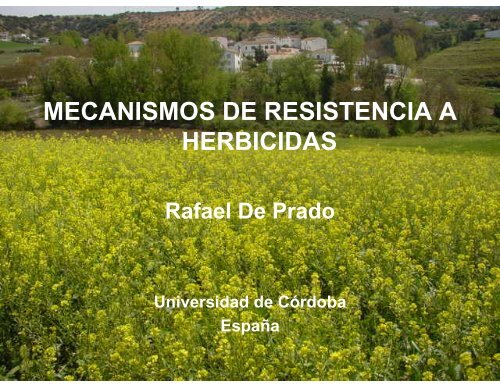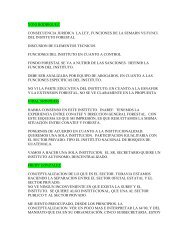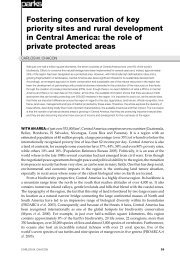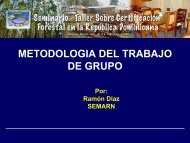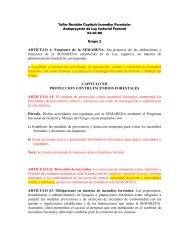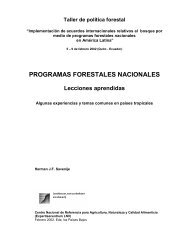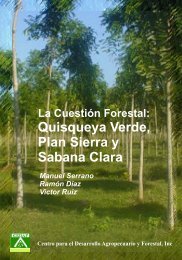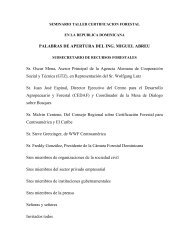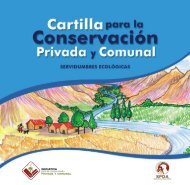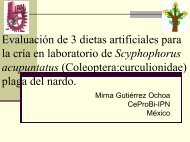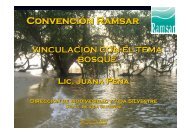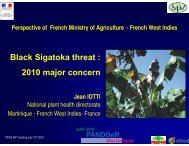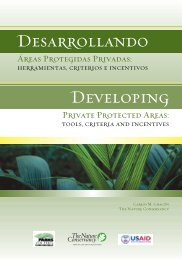Presentación - CEDAF
Presentación - CEDAF
Presentación - CEDAF
- No tags were found...
You also want an ePaper? Increase the reach of your titles
YUMPU automatically turns print PDFs into web optimized ePapers that Google loves.
UniversityofCórdobaEvolution of number of herbicide in wheat, olive, stone fruit,vineyard and citrus in Spain.
University ofCórdobaAnalysis of the risk of the presence ofherbicide-resistant weedsRisk level Low 1 Medium3 High 5 Value1. Number of different crops in the rotation >3 2 o 3 12. Relation between winter crops (I) / spring crops (P) IP I3. Tillage of the soil in the rotation: Tillage (L) / No Tillage L>NL NL>L NL(NL)4. Mechanical control >Twice 1 only None5. Number of different herbicides (mode of action) for theweed control in the rotation6. During how many consecutive growing seasons have youused herbicides with the same mode of action?>3 2 1>3 2 Alwaysthe same7. Have you used herbicides with the same mode of action No Once >Twiceduring the growing season?.8. Level of infestation of the plot Low Medium High9. Quality of control obtained by the herbicide during the last3 or 4 yearsIf the TOTAL number is under 18 Low riskIf the TOTAL number is between 18 and 32 Moderate riskIf the TOTAL number is over 32 High riskGoodConstantMediumVariableInsufficientDecreasingTOTAL ¿?
UniversityofCórdobaThe evolution of Herbicide Resistance(percent values are arbitrary)Tharayil-Santhakumar, N. 2003
SUSCEPTIBLESUSCEPTIBLEThe Weed Science Society of America (WSSA) definesherbicide resistance as:RESISTANT“the inherited ability of a plant to survive and reproducefollowing exposure to a dose of herbicide normally lethal tothe wild type”.
Distribución n de la resistencia en Latinoamérica3329355Hugo Cruz-Hipólito, 2010
Control de malas hierbasÉpoca de controlHerbicidasMomento de laemergenciaMedios demanejoRotaciónde cultivosHugo Cruz-Hipólito, 2010Variedaddel cultivoDistanciaentre hilerasDensidad de siembra
Resistencia cruzadaALS INHIBIDORES ACCasa INHIBIDORES PSII INHIBIDORESBIOTIPO SENSIBLESISTEMA DE DETOXIFICACIÓNSTOP ALSBIOTIPO RESISTENTEBIOTIPO RESISTENTE
Simulation model of Arabidopsis AHAS structure in complex with the SU herbicide chlorsulfuron (a)or the IMI herbicide imazaquin (b). The herbicides are colored white; the residues that have evolvedresistance substitutions are colored red. Note that the SU herbicide is bound deeper and closer toand has more contact with the catalytic site than does the IMI herbicide. The perspective of theimages is that the atoms of the herbicides at the bottom left are those that are at the entrance of thechannel, and those at the top right are inside the channel, leading to the catalytic site. (S. Friesen &S. Powles, unpublished data.)
ALS amino acid substitutions that confer herbicide resistance.AARN SCR Weed Species SU (2) IMI (2) PTB (2) TP (2) SCT (2) Year (3)Pro 197* His Lactuca serriola R r S r ND 1992His Papaver rhoeas R S ND r ND 2004His Scirpus juncoides var. ohwianus R S S ND ND 2007His Scirpus mucronatus R R R R R 2009AARN =Amino Acid Residue and NumberSCR=Substitution conferring resistanceSU = SulfonylureasIMI = ImidazolinonesPTB= PyrimidinylthiobenzoatesTP= TriazolopyrimidinesSCT=SulfonylaminocarbonyltriazolinoneAdaptado de Copyright © 1993-2009 WeedScience.org.
Resistencia múltipleALS INHIBIDORESACCasa INHIBIDORESPSII INHIBIDORESBIOTIPO SENSIBLESISTEMA DEDETOXIFICACIÓNBIOTIPO RESISTENTESTOP ACCasaSTOP PSII
Resistencia de Lolium rigidum a diferentes grupos de herbicidasInhibidoresPS II y PS IInhibidoresALSInhibidoresACCAsaInhibidoresMitosisInhibidoresEPSPSOtros modos deaccións-TriazinasSulfonilureasAPPsDinitroanilinasGlicinaCloroacetamidasUreassustituidasTriazinonasImidazolinonasDIMsCarbamatosIsoxazoles1-4 triazolesS. Powles et al., 2007. Glyphosate, paraquat and ACCase multipleherbicide resistance evolved in a L. rigidum biotype. Planta: 225: 499-513.S. Powles et al., 2009. Distinct non-target site mechanisms endowresistance to glyphosate, ACCase and ALS-inhibiting herbicides in multipleherbicide-resistant L. rigidum. Planta: 230: 713-723.
HerbicidasEntrada en la planta(raíces o partesverdes)Entrada en células individualesSecuestración o ligacióna sustratosMetabolismo delherbicida - activaciónMetabolismo del herbicidadesactivaciónTranslocación(floema o xilema)Entrada en orgánulos subcelularesInteracción con el sitio dianaHugo Cruz-HipólitoConsecuencias tóxicas(muerte)
Mecanismos de resistencia(TSR)ModificaciónLugar AcciónSobreexpresiónAplicaciónherbicidaPlantaresistente
Resistencia de sitio de acciónPérdida de afinidad por el sitio de acciónAvena fatua. Recolectada en ChileHerbicida Accesión ED 50 FR I 50 FRFenoxaprop S 38,82 0,90R 201,79 5,20 2,71 3,01Diclofop S 37,76 35,19R 208,14 4,04 108,21 3,07Cletodim S 38,78 3,81R 201,24 5,19 8,69 2,28Cicloxidim S 38,72 7,83R 201,18 5,20 19,76 2,52
Table 3 Resistance-endowing plastidic ACCase CT domain amino acid substitutions in field-evolvedresistant grass weed speciesResistance spectrumAmino acid substitution Grass weed species APP CHD PPZ ReferencesIle-1781-Leu Alopecurus myosuroides R R R Petit et al., 2010Avena fatua R R r Christoffers y Pederson, 2007A. sterilis R R ? Liu et al., 2007Lolium multiflorum ? R ? White et al., 2005L. rigidum R R R Yu et al., 2007Setaria viridis R R ?Trp-1999-Cys A. sterilis R/S S ? Liu, 2007Trp-2027-Cys A. myosuroides R S R Petit et al., 2010A. sterilis R/r r ? Petit et al., 2010L. rigidum ? r ? Yu et al., 2007Ile-2041-Asn A. myosuroides R S r Petit et al., 2010A. sterilis R r ? Petit et al., 2010Phalaris paradoxa ? ? ? Hochberg et al., 2009L. rigidum R r/S ? Yu et al., 2007Ile-2041-Val L. rigidum S/R S ?Asp-2078-Gly A. myosuroides R R R Petit et al., 2010A. fatua R R R Cruz-Hipolito 2010A. sterilis R R ? Petit et al., 2010L. multiflorium R R R Kaundun, 2010L. rigidum R R R Yu et al., 2007P. paradoxa R R R Hochberg et al., 2009Cys-2088-Arg L. rigidum R R R Yu et al., 2007Gly-2096-Ala A. myosuroides R r/S S Petit et al., 2010
Glyphosate resistance resulting from gene amplification.Powles S B PNAS 2010;107:955-956©2010 by National Academy of Sciences
Mecanismos de resistencia(NTSR)AbsorciónSuperficie foliarCutículaApoplastoTranslocaciónSistematizaciónMetabolizaciónAplicaciónherbicidaPlantaresistenteHugo Cruz-Hipólito
Resistencia fuera del sitio de acciónMetabolización a especies no tóxicastTabla 2. Resumen de las tres fases del metabolismo de plaguicidas (Adaptado deSHIMABUKURO, 1985; DE PRADO et al., 2004)CaracterísticasPropiedadesinicialesReacciones Compuesto inicial Oxidación,hidrólisis,reducciónSolubilidadFototoxicidadLipofílicoTóxicoFase I Fase II Fase IIIAnfofílicoModificado omenos tóxicoMovilidad Selectiva Modificada oreducidaConjugaciónHidrofílicoMuy reducida ono tóxicoLimitada oinmóvilConjugaciónsecundaria oincorporación abiopolímerosHidrofílico oinsolubleNo tóxicoInmóvil
Acetil Coenzima A carboxilasa (ACCasa(ACCasa)• ACCasa, acetil coenzima A carboxilasa.• Cataliza el primer paso en la biosíntesis de ácidos grasos.Hugo Cruz-Hipólito
.Metabolismo de 14 C-fenoxaprop-p-etil 24 HDT en L. multiflorum.Absorción foliar.
Figura 5. Ruta metabolica de detoxificación de fenoxaprop-etilo etilo enLoliun multiflorum.
Resistencia fuera del sitio de acciónReducción n de la concentración n de herbicida en elLack of Herbicide Penetrationsitio de acciónSR
Especies de malezas que incrementan su grado de infestación en soja transgénicaresistente a glifosato en Argentina 1 .Nombre científicoAnoda cristata (L.) Schltdl.Artemisia annua L.Clematis montevidensis SprengCommelina erecta L.Conyza bonariensis (L.) Cronq. 2Convolvulus arvensis L.Eleusine indica (L.) Gaertn 3Hybanthus parviflorus (L.f.) Baill.Ipomoea purpurea (L.) Roth and other speciesIresine diffusa Humb and Bonpl.Oenothera indecora CambessParietaria debilis G. FosterPetunia axillaris (Lam.) Britton, Sterns & Pogg.Rumex crispus L.Sida rhombifolia L.Solanum chacoense Bitter.Spharalcea bonariensis (Cav.) Griseb.Trifolium repens L.Verbena bonaerensis L.Viola arvensis MurrWedelia glauca Oct. Hoffmann1Recopilado de Valverde B. y Gressel J. , 2006.2Reportada como resistente a glifosato en Brasil, España y Sudáfrica.3Reportada como resistente a glifosato en Malasia, Taiwán y Bolivia.
Resistente (M: 3000)Resistente (M: 1000)Susceptible (M: 2500)
Ceras epicuticulares2µm²Cuantificación con un CAD softwareÁrea cubierta por ceras (%)SR42,9 (0,66) 102,6 (2,38)
Resistencia fuera del sitio de acciónResistencia asociada a procesos de secuestración n o compartimentaciónFigura 7. Rutas metabólicas de detoxificación de herbicidas en malezas (Adaptado de DE PRADO y FRANCO, 2004).
GRACIAS
Sitio de acción n del isoproturón
Detoxificación de isoproturon en Loliun rigidum. Absorción radicularSRDe Prado et al., J. Agric. Food Chem, Vol.56, No. 6. 2005.
Efecto de ABT (70µM) sobre el metabolismo de 14 C-isoproturón en hojas de Lolium rigidum (R y S)incubados en herbicida durante 24 h y luego transferidos a solución nutritiva 24 h.a ISO, isoproturón; M-ISO, monodesmetil-isoproturon; H-ISO, hidroxi-isoproturón;C-ISO, conjugado-isoproturón.De Prado et al., J. Agric. Food Chem, Vol.56, No. 6. 2005.
Figura 4. Ruta metabolica de detoxificación de isoproturon en Loliun rigidum.
Acetil Coenzima A carboxilasa (ACCasa(ACCasa)• ACCasa, acetil coenzima A carboxilasa.• Cataliza el primer paso en la biosíntesis de ácidos grasos.Hugo Cruz-Hipólito
.Metabolismo de 14 C-fenoxaprop-p-etil 24 HDT en L. multiflorum.Absorción foliar.
Figura 5. Ruta metabolica de detoxificación de fenoxaprop-etilo etilo enLoliun multiflorum.


